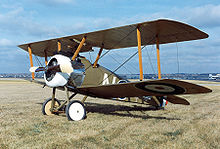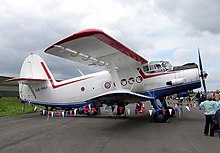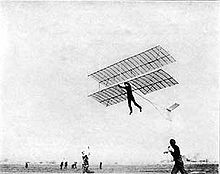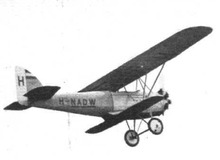Biplane

Reproduction of a Sopwith F.1 Camel biplane.

The Antonov An-2 is the largest single-engine biplane design and has the longest production history of any biplane,[1] and the second longest of any aeroplane.
A biplane is a fixed-wing aircraft with two main wings stacked one above the other. The first powered, controlled aeroplane to fly, the Wright Flyer, used a biplane wing arrangement, as did many aircraft in the early years of aviation. While a biplane wing structure has a structural advantage over a monoplane, it produces more drag than a similar unbraced or cantilever monoplane wing. Improved structural techniques, better materials and the quest for greater speed made the biplane configuration obsolete for most purposes by the late 1930s.
Biplanes offer several advantages over conventional cantilever monoplane designs: they permit lighter wing structures, low wing loading and smaller span for a given wing area. However, interference between the airflow over each wing increases drag substantially, and biplanes generally need extensive bracing, which causes additional drag.
Biplanes are distinguished from tandem wing arrangements, where the wings are placed forward and aft, instead of above and below.
The term is also occasionally used in biology, to describe the wings of some flying animals.
Contents
1 Characteristics
1.1 Advantages and disadvantages
1.2 Stagger
1.3 Bays
1.4 Sesquiplane
2 Ultralight aircraft
3 History
4 In avian evolution
5 See also
6 References
6.1 Citations
6.2 Bibliography
7 External links
Characteristics

Biplane hang glider under tow. Philadelphia, US, 1920s.
In a biplane aircraft, two wings are placed one above the other. Each provides part of the lift, although they are not able to produce twice as much lift as a single wing of similar size and shape because the upper and the lower are working on nearly the same portion of the atmosphere and thus interfere with each other's behaviour. For example, in a wing of aspect ratio 6, and a wing separation distance of one chord length, the biplane configuration will only produce about 20 percent more lift than a single wing of the same planform.[2]
In the biplane configuration, the lower wing is usually attached to the fuselage, while the upper wing is raised above the fuselage with an arrangement of cabane struts, although other arrangements have been used. Either or both of the main wings can support ailerons, while flaps are more usually positioned on the lower wing. Bracing is nearly always added between the upper and lower wings, in the form of wires (tension members) and/or slender interplane struts positioned symmetrically on either side of the fuselage.
Advantages and disadvantages
The primary advantage of the biplane over a monoplane is to combine great stiffness with light weight. Stiffness requires structural depth and, where early monoplanes had to have this added with complicated extra bracing, the box kite or biplane naturally has a deep structure and is therefore easier to make both light and strong. A braced monoplane wing must support itself fully, while the two wings of a biplane help to stiffen each other. The biplane is therefore inherently stiffer than the monoplane. Also, the structural forces in the spars of a biplane wing tend to be lower, so the wing can use less material to obtain the same overall strength and is therefore much lighter. A disadvantage of the biplane was the need for extra struts to space the wings apart, although the bracing required by early monoplanes reduced this disadvantage.
The low power supplied by the engines available in the first years of aviation meant that aeroplanes could only fly slowly. This required an even lower stalling speed, which in turn required a low wing loading, combining both large wing area with light weight. A biplane wing of a given span and chord has twice the area of a monoplane the same size and so can fly more slowly, or for a given flight speed can lift more weight.[citation needed] Alternatively, a biplane wing of the same area as a monoplane has lower span and chord, reducing the structural forces and allowing it to be lighter.[3]
Biplanes suffer aerodynamic interference between the two planes. This means that a biplane does not in practice obtain twice the lift of the similarly-sized monoplane. The farther apart the wings are spaced the less the interference, but the spacing struts must be longer. Given the low speed and power of early aircraft, the drag penalty of the wires and struts and the mutual interference of airflows were relatively minor and acceptable factors. As engine power rose after World War One, the thick-winged cantilever monoplane became practicable and, with its inherently lower drag and higher speed, from around 1918 it began to replace the biplane in most fields of aviation.
The smaller biplane wing also allows greater maneuverability. During World War One, this further enhanced the dominance of the biplane and, despite the need for speed, military aircraft were among the last to abandon the biplane form. Specialist sports aerobatic biplanes are still occasionally made.
Stagger
Biplanes were originally designed with the wings positioned directly one above the other. Moving the upper wing forward relative to the lower one is called positive stagger or, more often, simply stagger. It can help increase lift and reduce drag by reducing the aerodynamic interference effects between the two wings. Many biplanes have such staggered wings. A common example from the 1930s is the layout found for the Waco Standard Cabin series.
It is also possible to place the lower wing's leading edge ahead of the upper wing, giving negative stagger. This is usually done in a given design for practical engineering reasons. Examples of negative stagger include the Sopwith Dolphin and Beechcraft Staggerwing. However, positive (forward) stagger is more common because it improves both downward visibility and ease of cockpit access for open cockpit biplanes.
Bays
The space enclosed by a set of interplane struts is called a bay (much as the architectural form is used), hence a biplane or triplane with one set of such struts connecting the wings on each side of the aircraft is a single-bay biplane.
This provided sufficient strength for smaller aircraft such as the First World War-era Fokker D.VII fighter and the Second World War de Havilland Tiger Moth basic trainer.
The larger two-seat Curtiss JN-4 Jenny is a two bay biplane, the extra bay being necessary as overlong bays are prone to flexing and can fail. The SPAD S.XIII fighter, while appearing to be a two bay biplane, has only one bay, but has the midpoints of the rigging braced with additional struts; however, these are not structurally contiguous from top to bottom wing. The Sopwith 1 1⁄2 Strutter has a W shape cabane, however as it does not connect the wings to each other, it does not add to the number of bays.
Large transport and bombing biplanes often needed still more bays to provide sufficient strength. These are sometimes referred to as multi-bay biplanes. A small number of biplanes, such as the Zeppelin-Lindau D.I have no interplane struts and are referred to as being strutless.

Zeppelin-Lindau D.I strutless biplane.

Nieuport 23 single-bay sesquiplane.

SPAD S.XIII single-bay biplane with auxiliary struts.

Curtiss JN-4 two-bay biplane.

Handley Page V/1500 four-bay or multi-bay biplane.
Sesquiplane

The Pander E showing its sesquiplane configuration in flight.
The sesquiplane is a common variation on the biplane where one wing (usually the lower) has not more than half the surface area of the other.[4] The name means "one-and-a-half wings." The arrangement may reduce interference drag between the wings whilst retaining the biplane's structural advantage. The 1920s Pander E is an example of an aircraft with a lower wing of exactly half the span and nearly one quarter (23%) of the area of the upper one. Some designs keep the upper and lower spans nearly equal whilst reducing the lower chord, of which the best known examples are probably the Nieuport military aircraft—from the Nieuport 10 through to the Nieuport 27, all designed by Gustave Delage during the Great War. The later Waco Custom Cabin series proved to be a popular example in general aviation. Another notable sesquiplane was the German Junkers J.I armored ground attack aircraft which was the first all-metal combat aircraft to be mass-produced and enter service.
Ultralight aircraft

Renegade Spirit with Rotax 618 engine.
Although most ultralights are monoplanes, the low speeds and simple construction involved have inspired a small number of biplane ultralights, such as Larry Mauro's Easy Riser (1975–). Mauro also made a version powered with solar cells driving an electric motor—called the Solar Riser. Mauro's Easy Riser was used by the man who became known as "Father Goose", Bill Lishman.[5]
Other biplane ultralights include the Belgian-designed Aviasud Mistral, the German FK12 Comet (1997–), the Lite Flyer Biplane[6][7] and the Murphy Renegade.
History

The Handley Page H.P.42, a large all-metal biplane airliner of the 1930s. Note the Warren truss interplane struts.
The biplane configuration was developed from the box kite, invented by the Australian Lawrence Hargrave.[8] By 1896 Octave Chanute was flying biplane hang gliders and concluded that the externally braced biplane offered better prospects for powered flight than the monoplane. The Wright Flyer biplane of 1903 became the first successful powered aeroplane.
Throughout the pioneer years, both biplanes and monoplanes were common, but by the outbreak of the First World War biplanes had gained favour due to a number of monoplane structural failures that resulted in the RFC's "Monoplane Ban" when all monoplanes in military service were grounded, while the French also withdrew most monoplanes from combat roles and relegated them to training.
During the period from 1914 to 1925 most new aircraft were biplanes although by 1918, the Germans were experimenting with a new generation of monoplanes such as the Junkers D.I and Fokker D.VIII that might have ended the biplane's advantages earlier had the war not ended when it had, and the French already had the Morane-Saulnier AI strut braced parasol monoplane in service. Sesquiplane types, which were biplanes with abbreviated lower wings such as the French Nieuport 17 and German Albatros D.III, offered slightly lower drag than a conventional biplane while being stronger than a monoplane.
As the available engine-power and speed increased, the drag penalty of external bracing limited aircraft performance. In order to fly faster, it would be necessary to do away with the external bracing to create an aerodynamically clean wing. Early cantilever designs were too weak or too heavy. The 1917 Fokker V.4 prototype (identified by some as the V.3) was a cantilever triplane but suffered excessive flexing of the wings, while the all-metal Junkers J 1 cantilever monoplane of 1915 was overweight and had a poor rate of climb from its use of electrical steel sheet for its construction.

Boeing Stearman E75 (PT-13D) biplane of 1944.
By the 1930s biplanes had reached their performance limits, and monoplanes had become predominant, particularly in continental Europe where monoplanes had been common from the end of World War I. At the start of World War II, several air forces still had biplane combat aircraft in front line use but they were clearly uncompetitive, and most were used in specialist roles, such as training or shipboard operation, until shortly after the end of the war. The British Gloster Gladiator and the Italian Fiat CR.42 biplane fighters were both still operational after 1939.[9] The German Heinkel He 50 and the Soviet Polikarpov Po-2 were both used in the night ground attack role until late in the war; the latter was even used by the Korean People's Air Force in the Korean War for night bombing. The British Fleet Air Arm flew Fairey Swordfish torpedo bombers from its aircraft carriers in the anti-submarine warfare role until the end of the war because they could operate from the decks of small escort carriers. The Swordfish was especially well suited to its role and outlived its intended replacement.
Later biplane trainers included the de Havilland Tiger Moth in the RAF, RCAF and others, the Stampe SV.4 in the French and Belgian Air Forces, the Boeing Stearman in the USAAF and the Naval Aircraft Factory N3N with the US Navy. In later civilian use, the Stearman became particularly associated with stunt flying such as wing-walking.

A 1997 model WACO Classic YMF-5C.
Modern biplane designs still exist in specialist niche roles such as aerobatics and agricultural aircraft with the competition aerobatics role and format for such a biplane well-defined in the mid-1930s by the Udet U 12 Flamingo. The Pitts Special dominated aerobatics for many years after World War II and is still in production.
The vast majority of biplane designs have been fitted with reciprocating engines of comparatively low power; exceptions include the Antonov An-3 and WSK-Mielec M-15 Belphegor, fitted with turboprop and turbofan engines respectively. Some older biplane designs, such as the Grumman Ag Cat and the aforementioned An-2 (in the form of the An-3) are available in upgraded versions with turboprop engines.
The two most produced biplane designs are the 1913 British Avro 504 (11,303 built) and the 1928 Soviet Polikarpov Po-2 (over 20,000 built), and coincidentally with the Po-2 being the direct replacement for the Soviet copies of the Avro 504.
In avian evolution
It has been suggested the feathered dinosaur Microraptor glided, and perhaps even flew, on four wings, which were held in a biplane-like arrangement. This was made possible by the presence of flight feathers on both the forelimbs and hindlimbs of Microraptor, and it has been suggested the earliest flying ancestors of birds may have possessed this morphology, with the monoplane arrangement of modern birds evolving later.[10]
See also
- History of aviation
- Monoplane
- Tandem wing
- Triplane
References
Citations
^ Gordon, Yefim & Komissarov, Dmitry. “Antonov An-2”. Midland. Hinkley. 2004. .mw-parser-output cite.citationfont-style:inherit.mw-parser-output .citation qquotes:"""""""'""'".mw-parser-output .citation .cs1-lock-free abackground:url("//upload.wikimedia.org/wikipedia/commons/thumb/6/65/Lock-green.svg/9px-Lock-green.svg.png")no-repeat;background-position:right .1em center.mw-parser-output .citation .cs1-lock-limited a,.mw-parser-output .citation .cs1-lock-registration abackground:url("//upload.wikimedia.org/wikipedia/commons/thumb/d/d6/Lock-gray-alt-2.svg/9px-Lock-gray-alt-2.svg.png")no-repeat;background-position:right .1em center.mw-parser-output .citation .cs1-lock-subscription abackground:url("//upload.wikimedia.org/wikipedia/commons/thumb/a/aa/Lock-red-alt-2.svg/9px-Lock-red-alt-2.svg.png")no-repeat;background-position:right .1em center.mw-parser-output .cs1-subscription,.mw-parser-output .cs1-registrationcolor:#555.mw-parser-output .cs1-subscription span,.mw-parser-output .cs1-registration spanborder-bottom:1px dotted;cursor:help.mw-parser-output .cs1-ws-icon abackground:url("//upload.wikimedia.org/wikipedia/commons/thumb/4/4c/Wikisource-logo.svg/12px-Wikisource-logo.svg.png")no-repeat;background-position:right .1em center.mw-parser-output code.cs1-codecolor:inherit;background:inherit;border:inherit;padding:inherit.mw-parser-output .cs1-hidden-errordisplay:none;font-size:100%.mw-parser-output .cs1-visible-errorfont-size:100%.mw-parser-output .cs1-maintdisplay:none;color:#33aa33;margin-left:0.3em.mw-parser-output .cs1-subscription,.mw-parser-output .cs1-registration,.mw-parser-output .cs1-formatfont-size:95%.mw-parser-output .cs1-kern-left,.mw-parser-output .cs1-kern-wl-leftpadding-left:0.2em.mw-parser-output .cs1-kern-right,.mw-parser-output .cs1-kern-wl-rightpadding-right:0.2em
ISBN 1-85780-162-8
^ Airplane Aerodynamics, Dommasch and Lomb, 1961 ed.
^ Berriman (1913), Page 26.
^ Gunston, Bill (2009). Cambridge Aerospace dictionary (2nd ed.). Cambridge, UK: Cambridge University Press. p. 606. ISBN 978-0-521-19165-4.
^ Larry Mauro and Bill Lishman
^ Lite Flyer Biplane
^ Pilotmix.com
^ Wragg, D.; Flight Before Flying, Osprey, 1974.
^ Coggins, Edward V (2000), Wings That Stay On Turner Publishing Company,
ISBN 1-56311-568-9 (p. 20)
^ Chatterjee S, Templin RJ (30 January 2007). "Biplane wing planform and flight performance of the feathered dinosaur Microraptor gui". Proc Natl Acad Sci USA. 104 (5): 1576–80. Bibcode:2007PNAS..104.1576C. doi:10.1073/pnas.0609975104. PMC 1780066. PMID 17242354.
Bibliography
- Berriman, A.E.; Aviation, Methuen, 1913.
External links
| Wikimedia Commons has media related to Biplanes. |
- Historical Collection of Biplane Pictures
- Jacqui Hayes: Bird wings evolved from biplane dinosaurs, Cosmos (magazine)
Spicerweb.org, Octave Chanute biplane hang glider





